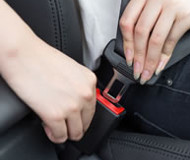Article from: www.thenewspaper.com/news/64/6457.asp
5/8/2018
Federal Stats Show Alcohol, Seatbelt Use More Relevant Than Speed
US Department of Transportation statistics demonstrate driving sober, buckled up and in an SUV has more impact on safety than speed.
 Federal traffic fatality data released last week confirm that drinking, shifting demographics and seat belt use are the factors with the greatest impact on road safety. The new data show traffic fatalities continue to fall from the pre-recession peak of 1.46 deaths per hundred million miles traveled in 2005. Last year, the figure was 1.17. The preliminary 2017 number does represent an increase over the all-time low of 1.08 in 2014.
Federal traffic fatality data released last week confirm that drinking, shifting demographics and seat belt use are the factors with the greatest impact on road safety. The new data show traffic fatalities continue to fall from the pre-recession peak of 1.46 deaths per hundred million miles traveled in 2005. Last year, the figure was 1.17. The preliminary 2017 number does represent an increase over the all-time low of 1.08 in 2014.
In their attempt to keep those figures as low as possible, federal authorities have devoted the largest share of the national traffic safety budget to the bankrolling of speed traps, even though only 7 percent of accidents were caused by drivers exceeding the posted limit.
A closer look at the new numbers show alcohol use proved a much more significant factor than exceeding the posted limit. One out of every five drivers killed in an accident had a blood alcohol reading of 0.08 or more, according to data released last week. The data also confirm that a change in the national vehicle fleet has had a big impact. The number of coupes and sedans on the road dropped from 139 million in 2008 to 134 million in 2016, while another 31 million trucks and SUVs were added to the road. With a 21 percent lower fatality rate, the shift toward trucks and SUVs helped push down the overall fatality rate.
Seatbelt use also remains a critical factor in federal statistics. In 56 percent of deadly nighttime crashes, and 41 percent of daytime incidents, the driver failed to buckle up, making it the single most important factor noted in the new statistics. The National Highway Traffic Safety Administration decided for the first time to double-check whether seatbelt usage statistics were skewed by misreported data. The agency grabbed black box data to see whether self-reporting of seatbelt use after an accident matched up with reality (view report in 1mb PDF file).
"The electronic data recorder data confirm that crash databases have over-reported belt use for drivers and, consequently, would have exaggerated the fatality- and injury-reducing effectiveness of belts for drivers if it had been directly estimated with the belt use reported in the database, without any correction factor such as the one used by NHTSA," the agency's new study reported.
In 411 crash cases, the black box data was obtained and checked against the correction factor, but investigators need more data to determine for sure whether the correction factor used is enough.
"It seems appropriate to continue with the existing estimates that belts reduce overall fatality risk by 45 percent for drivers and right front passengers of cars and by 60 percent in light trucks and vans," the report concluded.
The new passenger vehicle safety statistics are available in a 700k PDF file at the source link below.
Source: Traffic Safety Facts: Passenger Vehicles (National Highway Traffic Safety Administration, 4/30/2018)
Permanent Link for this item
Return to Front Page
 Federal traffic fatality data released last week confirm that drinking, shifting demographics and seat belt use are the factors with the greatest impact on road safety. The new data show traffic fatalities continue to fall from the pre-recession peak of 1.46 deaths per hundred million miles traveled in 2005. Last year, the figure was 1.17. The preliminary 2017 number does represent an increase over the all-time low of 1.08 in 2014.
Federal traffic fatality data released last week confirm that drinking, shifting demographics and seat belt use are the factors with the greatest impact on road safety. The new data show traffic fatalities continue to fall from the pre-recession peak of 1.46 deaths per hundred million miles traveled in 2005. Last year, the figure was 1.17. The preliminary 2017 number does represent an increase over the all-time low of 1.08 in 2014.